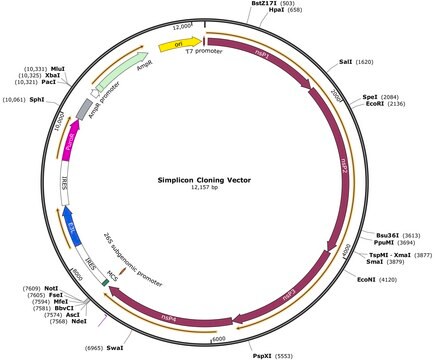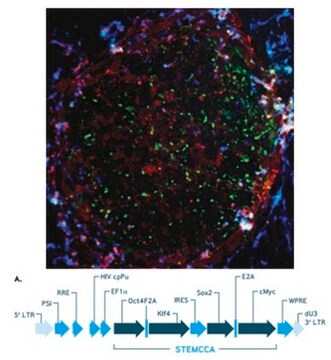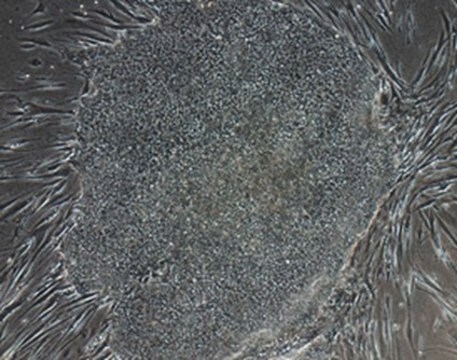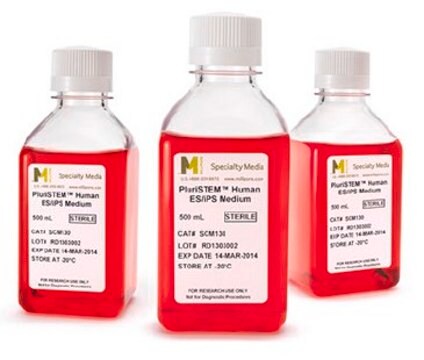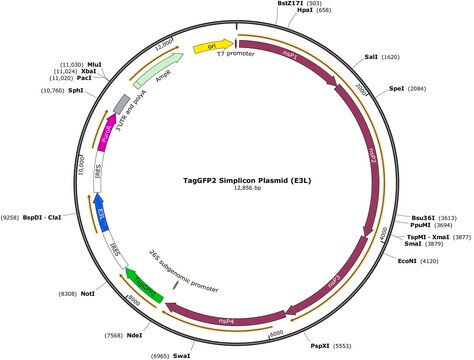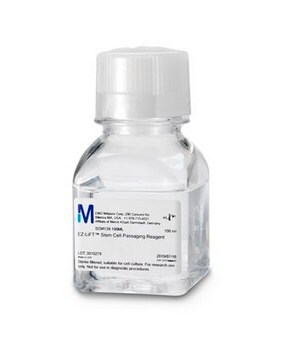SCR550
Simplicon® RNA Reprogramming Kit (OKSG)
Synonym(s):
RNA Kit, RNA Reprogramming Kit, Simplicon OKSG Kit
About This Item
Recommended Products
technique(s)
cell culture | stem cell: suitable
Quality Level
input
sample type induced pluripotent stem cell(s)
shipped in
dry ice
General description
EMD Millipore’s Simplicon RNA Reprogramming Kit is a safe and efficient method to generate integration free, virus-free human iPS cell using a single transfection step. The technology is based upon a positive strand, single-stranded RNA species derived from non-infectious (non-packaging), self-replicating Venezuelian equine encephalitis (VEE) virus3. The Simplicon RNA replicon is a synthetic in vitro transcribed RNA expressing all four reprogramming factors (OKS-iG; Oct4, Klf4, Sox2 and Glis1) in a polycistronic transcript that is able to self-replicate for a limited number of cell divisions.
View our Application Note! (See the Data!)
Application
• Integration-free, footprint-free iPS cells. No risk of genomic integration
• Safe, virus free, synthetic polycistronic RNA replicon (all four reprogramming factors in 1 RNA strand)
•Only 1-day transfection required. The RNA replicon is able to self-replicate, elliminating the need for laborious daily transfection of multiple individual mRNAs over a 14 day period.
• Efficient and rapid reprogramming.
• No screening required to ensure viral remnants are not present.
• Controlled elimination of synthetic RNA replicon by removal of B18R protein.
• Validated for reprogramming in feeder-based and feeder-free culture conditions.
Stem Cell Research
Components
2. B18R RNA: (Part No. CS210584) One (1) vial containing 10 µL of RNA (1 ug/uL). Store at -80°C.
3. Human Recombinant B18R Protein, Carrier-Free: (Part No. GF156) One (1) vial containing 50 ug of 0.5 mg/mL stock of B18R protein. Store at -80°C.
4. Human iPS Reprogramming Boost Supplement II: (Part No. SCM094). Store at -20°C.
Quality
Storage and Stability
• Human recombinant B18R protein: Stable for 4 months from date of receipt when stored appropriately at -80°C. For best recovery, quick-spin the vial prior to opening. Thaw on ice. While on ice, aliquot B18R protein into sterile, nuclease-free, low protein-binding eppendorf tubes and store at -80°C. B18R protein must be kept on ice in order to avoid degradation. Limit repeated freeze-thaw cycles. Use in a sterile RNAse-free environment.
• Human iPS Reprogramming Boost Supplement II: Stable for 4 months at -20˚C from date of receipt. Upon first thaw, aliquot into smaller working volumes and freeze at -20°C. Upon addition of the small molecule components to the media, filter the supplemented media with a 0.22 μM filtration unit and stored at 2-8˚C. For optimal results, prepare sufficient supplemented media for a 1 week supply of media changes.
Legal Information
Disclaimer
Storage Class Code
10-13 - German Storage Class 10 to 13
Certificates of Analysis (COA)
Search for Certificates of Analysis (COA) by entering the products Lot/Batch Number. Lot and Batch Numbers can be found on a product’s label following the words ‘Lot’ or ‘Batch’.
Already Own This Product?
Find documentation for the products that you have recently purchased in the Document Library.
Customers Also Viewed
Articles
Fibroblast growth factors (FGFs) are secreted glycoproteins that regulate several fundamental developmental pathways and help regulate mesoderm and ectoderm patterning in the early embryonic development.
The Simplicon™ RNA Reprogramming Technology is a next generation reprogramming system that uses a single synthetic, polycistronic self-replicating RNA strand engineered to mimic cellular RNA to generate human iPS cells.
Human iPSC neural differentiation media and protocols used to generate neural stem cells, neurons and glial cell types.
Our team of scientists has experience in all areas of research including Life Science, Material Science, Chemical Synthesis, Chromatography, Analytical and many others.
Contact Technical Service
